- Lab-STICC
- Calendar
- Phd defense : 5G scenarios and evolutions in the new millimeter-wave bands
Phd defense : 5G scenarios and evolutions in the new millimeter-wave bands
-
Location : IMT Atlantique, Rennes
Zoom acess : https://imt-atlantique.zoom.us/j/94538995101?pwd=LzVlTFRQd3FjdzhlY0lNcWtyNEtnZz09
Lecturer : Hamidou DEMBELE, PIM/DH, Phd student
Keywords : Millimeter-waves, 5G, blockage, link budget, multibeam antenna, block error rate
Abstract : The 5th generation (5G) of mobile communication systems is intended to offer a wide range of applications subject to various constraints in terms of throughputs, low latency communications and high network capacity to support a large number of connected devices. To face these challenging requirements, the use of millimeter-wave (mmWave) frequency bands has become one of the 5G key technologies due to the availability of huge amount of bandwidth. -In order to overcome the attenuation of electromagnetic waves in these frequency bands, directional antennas with narrow beams are recommended. -However, concentrating all energy towards the main propagation path through directional communication eliminates the diversity offered by the multipath and represents a real risk of a sudden interruption of communication in the event of obstacles (human or vehicle) in the beam pointing direction. Such a scenario is known as human (or vehicle) blockage phenomenon in mmWave bands.
This thesis deals with the impact of human blockage on 5G communication systems. The analysis of communication performance in terms of block error rate (BLER) with and without the influence of human blockage is proposed, thanks to the implementation of the 5G physical layer in a simulation tool. Based on BLER performance, a link budget is also established in order to evaluate the impact of blockage on the cell coverage. Furthermore, as multibeam antenna (MBA) systems represent a promising candidate to mitigate the effect of blocking, a generic and theoretical approach is proposed to model such an antenna that can be used for performance prediction. The validation with the existing MBAs in different frequency bands is carried out. The proposed antenna model is flexible, more complete and realistic for mmWave systems than the antenna models suggested in the standards.
